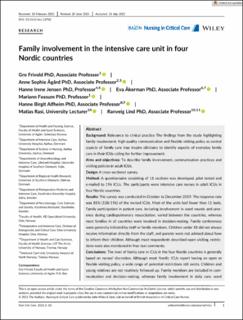| dc.contributor.author | Frivold, Gro | |
| dc.contributor.author | Ågård, Anne Sophie | |
| dc.contributor.author | Jensen, Hanne Irene | |
| dc.contributor.author | Åkerman, Eva | |
| dc.contributor.author | Fossum, Mariann | |
| dc.contributor.author | Alfheim, Hanne Birgit | |
| dc.contributor.author | Rasi, Matias | |
| dc.contributor.author | Lind, Ranveig | |
| dc.date.accessioned | 2021-08-19T11:10:06Z | |
| dc.date.available | 2021-08-19T11:10:06Z | |
| dc.date.created | 2021-08-18T14:35:15Z | |
| dc.date.issued | 2021 | |
| dc.identifier.citation | Nursing in Critical Care. 2021, 26, 1-10 | en_US |
| dc.identifier.issn | 1362-1017 | |
| dc.identifier.uri | https://hdl.handle.net/11250/2770273 | |
| dc.description.abstract | Background: Relevance to clinical practice The findings from the study highlighting family involvement, high-quality communication and flexible visiting policy as central aspects of family care may inspire clinicians to identify aspects of everyday family care in their ICUs calling for further improvement.
Aims and objectives: To describe family involvement, communication practices and visiting policies in adult ICUs.
Design: A cross-sectional survey.
Method: A questionnaire consisting of 11 sections was developed, pilot tested and e-mailed to 196 ICUs. The participants were intensive care nurses in adult ICUs in four Nordic countries. Results: The survey was conducted in October to December 2019. The response rate was 81% (158/196) of the invited ICUs. Most of the units had fewer than 11 beds. Family participation in patient care, including involvement in ward rounds and presence during cardiopulmonary resuscitation, varied between the countries, whereas most families in all countries were involved in decision-making. Family conferences were generally initiated by staff or family members. Children under 18 did not always receive information directly from the staff, and parents were not advised about how to inform their children. Although most respondents described open visiting, restrictions were also mentioned in free-text comments.
Conclusions: The level of family care in ICUs in the four Nordic countries is generally based on nurses' discretion. Although most Nordic ICUs report having an open or flexible visiting policy, a wide range of potential restrictions still exists. Children and young relatives are not routinely followed up. Family members are included in communication and decision-making, whereas family involvement in daily care, ward rounds and family-witnessed resuscitation seem to be areas with a potential for improvement. | en_US |
| dc.language.iso | eng | en_US |
| dc.publisher | Wiley | en_US |
| dc.relation.uri | https://onlinelibrary.wiley.com/doi/10.1111/nicc.12702 | |
| dc.subject | Intensivsykepleie | en_US |
| dc.subject | Intensiv nursing | en_US |
| dc.subject | Sykehus | en_US |
| dc.subject | Hospitals | en_US |
| dc.subject | Familier | en_US |
| dc.subject | Families | en_US |
| dc.subject | visiting policies | en_US |
| dc.subject | familycentred care | en_US |
| dc.subject | family presence | en_US |
| dc.subject | family involvement | en_US |
| dc.subject | communication practices | en_US |
| dc.subject | adult intensive care | en_US |
| dc.title | Family involvement in the intensive care unit in four Nordic countries | en_US |
| dc.type | Peer reviewed | en_US |
| dc.type | Journal article | en_US |
| dc.description.version | publishedVersion | en_US |
| dc.rights.holder | Open Access | en_US |
| dc.subject.nsi | VDP::Sykepleievitenskap: 808 | en_US |
| dc.subject.nsi | VDP::Nursing science: 808 | en_US |
| dc.source.pagenumber | 1-10 | en_US |
| dc.source.volume | 26 | en_US |
| dc.source.journal | Nursing in Critical Care | en_US |
| dc.identifier.doi | 10.1111/nicc.12702 | |
| dc.identifier.cristin | 1926990 | |
| cristin.ispublished | true | |
| cristin.fulltext | original | |
| cristin.qualitycode | 1 | |
